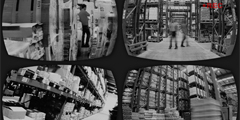 |
| ONVIF's 1.0 Core Specification debuted in 2008 at Security Essen |
The adoption of the ONVIF protocol by manufacturers continues to grow. Last year, the number of member companies in the ONVIF forum exceeded 500 and more than 5,000 products are currently certified on the ONVIF website. How did ONVIF achieve this amazing result and experience this wild adoption?
More than a decade ago, every manufacturer was defining their own protocols and pushing for Video Management Software (VMS) companies to implement them. Since each VMS had a different set of supported protocols, interoperability between devices and software was limited. Furthermore, by having many different implemented protocols, software companies had to maintain and fix versions between different releases of their applications.
When And Why Was ONVIF Started?
After a few years, while facing ever-growing complexity in developing interoperable solutions, the need for a common standard became strong. To fill this need, Axis, Bosch and Sony joined their efforts and in 2008, at Security Essen, announced the 1.0 release of the ONVIF Core Specification. Six months later, the first version of the ONVIF Device Test Tool was released. Since the beginning of the group’s activities, ONVIF’s focus was on a tool that each manufacturer could independently use to fully automate the validation of the implementation, without having to rely on external certification laboratories. After two months, the first conformant devices were published on the ONVIF website and one year after the first publication of the Core Specifications, 100 companies joined the ONVIF group and 200 devices were certified.
Formation Of The ONVIF Profile Concept
During the first two years of ONVIF’s activities, the focus was on video surveillance. In fact, version 1.0 and successive revisions of the Core Specifications were focused on fixed cameras and PTZ domes. To embrace a wider set of devices, such as PTZ-heads, NVRs or access control devices, the Core Specifications were updated to version 2.0, where only the functions that are shared between every IP device are included. Specialized functions, such as streaming specifications, were moved to a dedicated specification.
ONVIF profiles are a list of functions that a manufacturer needs to implement in its device to claim conformance with the ONVIF specifications |
By having a wider set of specifications and not just a single document anymore, it became crucial to precisely define the requirements for every type of device. To address this requirement, the concept of profiles was introduced. A profile is a list of functions that need to be implemented by a device for the manufacturer to claim conformance with the ONVIF specifications. In contrast to the specifications, which are continuously enhanced and extended to include support for newer device classes, a profile is immutable in time and it cannot be modified to include new features. In ONVIF, profiles are identified by letters, and a device and management software which are both conformant with the same profile both support the same functions to guarantee interoperability. Since the introduction of the profiles, a device cannot claim conformance to a revision of the ONVIF specification, but only to one or more profiles.
Types Of ONVIF Profiles
The first profile, Profile S for streaming, was released in December 2011, together with the release of the Device Test Tool 11.12. In two years, the number of devices that claimed conformance to the Profile S specification reached 1,200, and after another year exceeded 2,700. At the end of 2013, Profile C was released. This profile addresses access control for site information and configuration, event and alarm management and door access control. On July 2014, Profile G for edge storage and retrieval was released, including configuring, controlling and visualizing the recording jobs. Currently, Profile Q, aimed at supporting quick installation and out-of-the-box functionality of the device, is in Release Candidate phase.. A fifth profile, Profile A, which establishes an interface for access control clients and expands the configuration options for ONVIF conformant access control systems, is also in Release Candidate phase.
The ONVIF Use Case Working |
At this point, readers may wonder where the ONVIF group was next headed. In 2014, the ONVIF specifications were included in the ISO/IEC 62676 standard for Video Surveillance Systems, making ONVIF an official standard. The next revision of IEC 60839-11 will adopt the specifications that ONVIF developed for access control monitoring based on web services. IEC 60839-11 specifies minimum functionality, performance and testing methods for electronic access control systems and components used for physical access. The standard applies to electronic access control systems and components that are used in security applications for the granting of access and includes requirements for logging, identification and control of information.
ONVIF Use Case WG For Developing Future Profiles
To further extend the applications for its use, ONVIF recently formed a new Working Group (WG) charged with developing real-world use cases in response to current market demand. The work of the Use Case Working Group will be used as input for ONVIF specifications, the development of future profiles and to assist in updating and maintaining ONVIF’s technical roadmap. The Use Case WG collaborates primarily with ONVIF members, but can also interact with system integrators, system designers, ONVIF ecosystem stakeholders and others through meetings, workshops, tradeshows and conferences to gather feedback regarding current Profiles, future specifications and future Profile development. The working group will act as an additional “ear to the industry” and help ONVIF to extend its adoption in the security market.





















